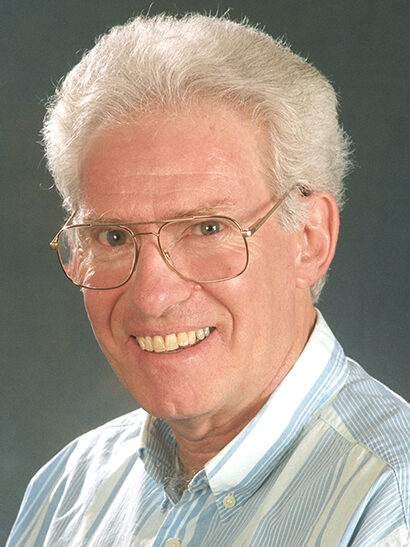IN MEMORIAM
Gary Steigman

This memorial obituary was originally published in Physics Today (2017) here. It was written by Robert Scherrer, John Beacom, Terry Walker, Keith Olive, and Michael Turner.
Gary Steigman, whose work was vital to the development of modern cosmology, particularly the application of particle physics and nuclear physics to cosmological questions, died on 9 April 2017 in Columbus, Ohio, of complications following a fall.
Born on 23 February 1941, Gary grew up in the Bronx, New York. A childhood fan of the New York Giants baseball team, he recounted to one of us (Scherrer) his memory of listening on the radio as Bobby Thomson hit the dramatic home run that propelled the 1951 Giants to the National League pennant. Gary received a BS in physics from the City University of New York in 1961 and his PhD, under the supervision of Mal Ruderman, from New York University in 1968. He joined the Institute of Theoretical Astronomy (now the Institute of Astronomy) at the University of Cambridge as a visiting fellow in 1968 and became a research fellow at Caltech in 1970. Then in 1972 he joined the faculty of Yale University. He left for the Bartol Research Institute at the University of Delaware in 1978 and was recruited to the Ohio State University in 1986.
Gary was seemingly ubiquitous on the cosmology conference circuit, so much so that he often referred to himself as the TWA Professor of Physics. Beginning in 1972 he spent 23 summers at the Aspen Center for Physics, where he served as a trustee in 1978–83, a member of the advisory board in 1983–98, and a longtime organizer of astrophysics workshops. Visitors to the Aspen Center will remember Holly, Gary’s Great Pyrenees dog, a fixture on his travels.
Gary’s contributions to cosmology span nearly half a century, beginning with his PhD dissertation, in which he showed that cosmologies with matter–antimatter symmetry were untenable: The universe must have an excess of baryons over antibaryons. He published his work in Nature and followed up in 1976 with an influential article in Annual Review of Astronomy and Astrophysics. Although the conclusion seems obvious now, it was certainly not so in the late 1960s; at that time, a symmetric universe could have been considered more natural. The origin of the observed baryon excess remains undetermined to this day, but Gary’s results underpinned the emergent research field of baryogenesis.
In 1977, in collaboration with James Gunn and David Schramm, Gary established a new limit, based on primordial nucleosynthesis, on the number of neutrino species. At the time, there were only weak experimental limits on the number of generations in the standard model of particle physics; Gary and his coauthors demonstrated that the number must be less than or equal to seven, a result later confirmed by measurements of the Z width from the Stanford Linear Collider and the Large Electron–Positron Collider. That demonstration was one of the first attempts to use cosmology to constrain particle physics, an area that blossomed in the 1980s following Gary’s groundbreaking work.
Gary and Schramm received first prize in the 1980 Gravity Research Foundation essay competition for a paper in which they explored a universe dominated by massive neutrinos; the essay was one of the earliest proposals for a nonbaryonic universe. Later, in a 1984 paper with one of us (Turner) and Lawrence Krauss, Gary raised the possibility of a cosmological constant to allow for a flat universe.
Gary’s most significant area of research was primordial nucleosynthesis. The field grew out of early work by James Peebles, Robert Wagoner, William Fowler, and Fred Hoyle in the 1960s, and because of an improved understanding of chemical evolution and better observational limits, primordial nucleosynthesis became the first true area of “precision cosmology” in the 1980s. In fact, until the later cosmic microwave background (CMB) results, primordial nucleosynthesis was the only area of precision cosmology. With longtime collaborators Schramm and three of us (Turner, Olive, and Walker), Gary focused on two major thrusts: deriving accurate estimates of the baryon density of the universe and constraining particle properties. A series of major papers in the 1980s and 1990s established a precise value for the baryon density of the universe, a prediction spectacularly confirmed by CMB measurements. Before the CMB results, we knew more about the first few minutes of the universe than about the next billion years.
More recently Gary renewed an earlier interest in relic particle abundances. Among his contributions were a series of improved calculations of those abundances, along with new constraints on fractionally charged relic particles and several important papers on dark radiation.
In 1986 Gary went to Ohio State to develop a cosmology research center that spanned both the physics and astronomy departments. His efforts yielded what is today the Ohio State Center for Cosmology and AstroParticle Physics, which has almost 30 faculty members and more than 15 postdocs.
For us, Gary was a collaborator, a mentor, and a good friend. He found his true companion in Sueli Viegas, his wife and fellow astronomer, with whom he wrote several papers. Gary deserves much of the credit for bringing together the fields of cosmology and nuclear and particle physics, a union that has proved enormously productive. Gary blazed a trail for others to follow, and he will be missed by all.

Positions Held
Trustee, 1977 – 1983
General Member, 1990 -1998